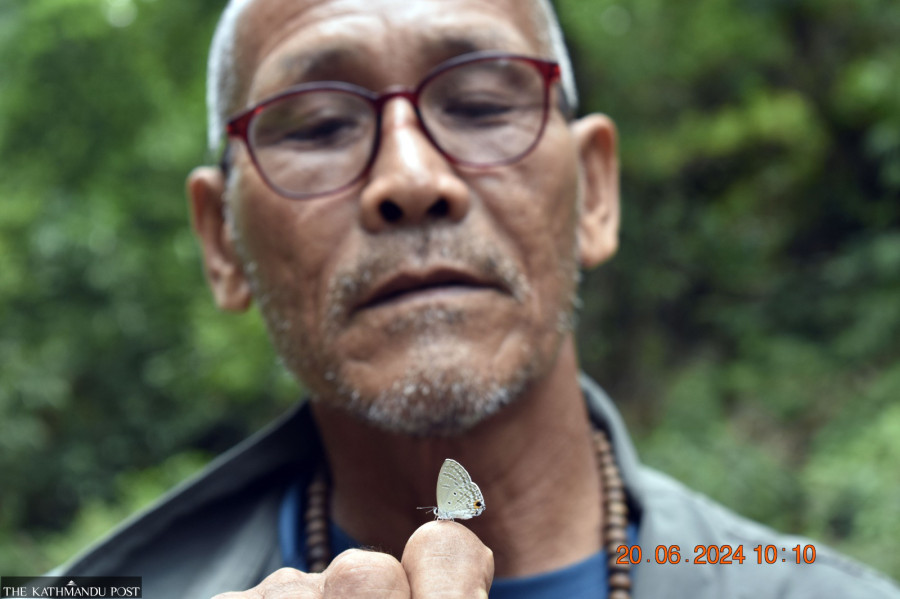Culture & Lifestyle
Chasing butterflies
Tekbahadur Gurung and Kapil Prasad Pokharel discuss photographing and collecting information on Chitwan’s colourful insects.
Ramesh Kumar Paudel
Who wouldn’t be delighted to spot a butterfly? Tekbahadur Gurung, a seasoned nature guide who leads tourists through Chitwan National Park, says, “Some foreign tourists visit just to see the butterflies.” Even if they don’t initially come for that, their interest grows once they encounter these vibrant insects.
Initially, Gurung knew little about butterflies. He wondered how he could explain them to tourists with little formal education. So, he started gathering information and began photographing every butterfly he encountered.
His friend Kapil Prasad Pokharel, who had been dedicated to the exact cause for a decade, supported him. Pokharel, formerly a nature guide, later became a wildlife technician with the National Trust for Nature Conservation, where he expanded his photography to include other animals and butterflies.
In addition to collecting butterfly photos, Gurung and Pokharel gathered extensive information about them. Realising this knowledge should be shared with the public, they published a book titled, ‘Field Guide: Butterflies of Chitwan, Nepal’.
“Although we gained practical experience, we are not scholars. We feared making mistakes if we published the book ourselves, so we looked for someone to guide us,” says Pokharel. Kiran Thapa, who holds an MSc in biology from Tribhuvan University, stepped in to help them.
The book was recently published, listing all three of their names as authors. It features 312 colourful butterfly photographs along with detailed descriptions. “While it may seem like this book is only for nature guides who work with tourists, it’s actually for anyone interested in biology—journalists wanting to learn about butterflies, researchers, and students,” said Gurung.
Gurung, a tourist guide for many years, often had to answer questions from foreign tourists about butterflies. On one occasion, he travelled to Kathmandu with two foreigners who had come to Chitwan to see birds. The tourists were thrilled to spot a butterfly in Kathmandu, and Gurung was surprised when they told him it was a rare species. This happened 20 years ago. “I had seen many butterflies in Chitwan, including those that foreigners found rare. After that incident, I became more curious about butterflies,” said Gurung.
As Gurung delved deeper into learning about butterflies, he realised that while many people were fascinated by tigers, rhinoceroses, and other large animals, few paid attention to butterflies. He noted that a healthy forest ecosystem supporting tigers is also essential for butterflies. Places with abundant water sources and diverse vegetation attract many butterflies. “But who will be as interested in a butterfly as they are in a tiger?” he remarked.
Gurung began photographing butterflies wherever he found them—whether in the forest, villages or market streets. To deepen his understanding, he relied on various resources. “Tiger Tops Jungle Lodge had some old information about Chitwan's butterflies. It includes details of about 100 species,” he said.
Gurung shared that Collen Smith, known as Putali Baje (grandfather of butterflies), documented 247 butterfly species in Chitwan.
Once, the Sauraha office of the National Trust for Nature Conservation organised a three-month wildlife survey in the Chure area. Gurung and Pokharel participated, strengthening their resolve to focus on butterflies.
During jungle safaris, walks, and boat trips, they started photographing butterflies and documenting details. After nearly ten years, they decided to publish a book. They consulted experts, including Pete, Nepali butterfly expert Bhaiya Khanal, and writer Mahendra Limbu, and reviewed Collen Smith’s records. They identified 312 butterfly species, 264 of which were found in Chitwan—17 more than Smith’s count. Gurung noted that butterflies, vital for the environment, biodiversity, and agriculture, face growing threats from pesticide use, deforestation, and urbanisation, which have reduced green spaces.
The book also includes information on invasive weed species like Mycania and Parthenium, which affect butterflies. It features photographs and details on butterflies’ importance and lifecycle. Gurung and Pokharel hope the book will aid in butterfly conservation efforts.




 16.29°C Kathmandu
16.29°C Kathmandu1.jpg)















